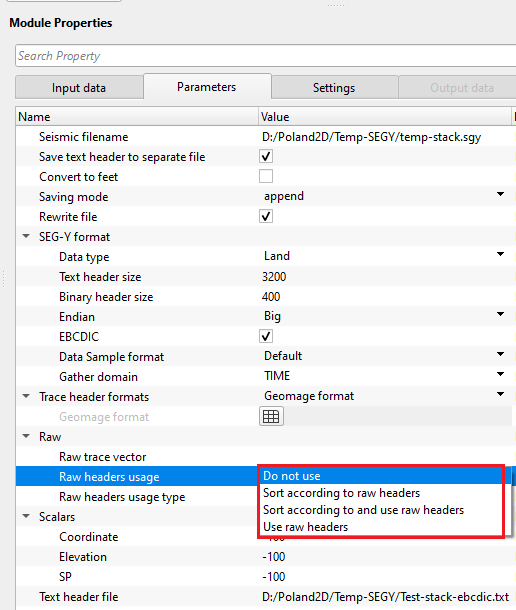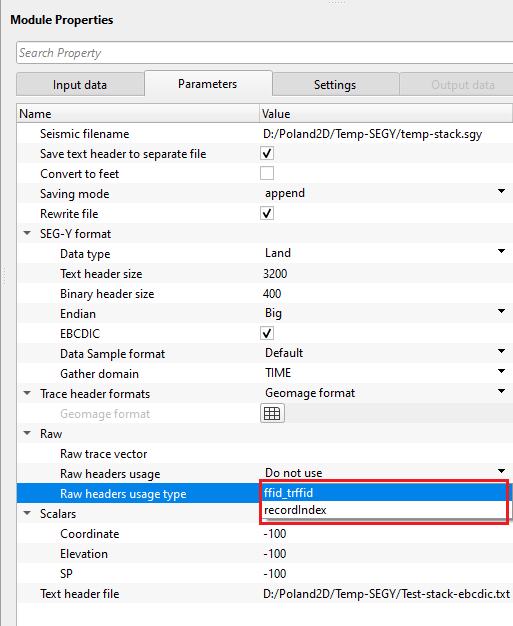Saving an internal file as standard SEG-Y file
![]()
![]()
During the seismic data processing, data is saved in an internal format, however, when the data needs to be sent to the client or outside of the seismic data processing contractor or to read in a different software, it must be in a standard format which can be readable by all software(s) programs. SEG-Y is a standard format which is widely used format to save the data.
This module allows the user to save an internal file into a SEG-Y file. This module can be used to save a pre-stack gather or post-stack gather as a SEG-Y file. Geomage internal trace header format is a standard SEG-Y rev 1.0
To edit any trace headers in the trace header format by using mathematical expressions , the user can visit this website to get to know more about it the general expression syntax and symbols at http://www.partow.net/programming/exprtk/index.html
![]()
![]()
Input DataItem -
Input gather - this input gather can be a pre-stack gather or post stack.
![]()
![]()
Seismic filename - provide the path and file name of the output segy gather. Extension should automatically assigned as ".sgy"
Save text header to separate file - this option allows the user to save the text/EBCDIC header separately in the same folder of the output SEGY file. By default, FALSE (Unchecked).
Convert to feet - this option converts the measuring system from metric to imperial. i.e., from meters to feet.
Saving mode { append, direct } - choose the saving mode from the drop down menu.
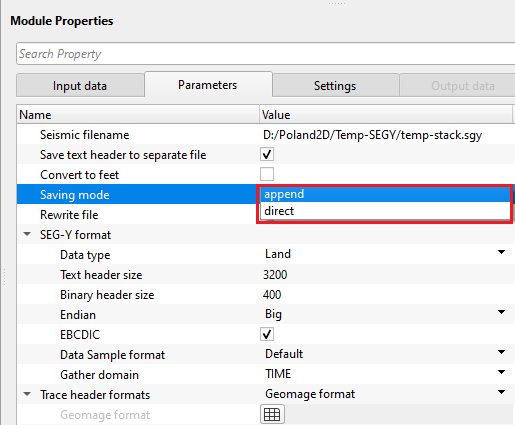
append - it saves/writes the traces one after the other.
direct - it saves/writes the traces as per the record index. If there are any missing trace indexes, the output file will have missing traces.
Rewrite file - it will overwrite the output file. By default, FALSE (Unchecked).
SEG-Y format - This section deals with the basic SEGY format details like type of data i.e. land/marine/transition, EBCDIC, binary headers information etc.
Data type - specify the input data type from the drop down menu. There are 3 types available. Land, Marine, Transition.

Text header size - text header stores the survey and processing history information. This is in ASCII format. The default size is 3200 bytes. This is also known as EBCDIC header. The standard size of the text header is 40 rows and 80 columns.
Binary header size - this header stores the data in binary format. Default size is 400 bytes. In this header, we get sample interval, no of samples, measurement system, data format (IBM, floating point, ....) etc. information is stored.
Endian - it refers to the byte order in which a computer stores the multi byte (integers, floating point etc) data in memory or files.

Big Endian - Most Significant Byte is stored at Lowest memory address. Most old computers used Big Endian.
Little Endian - Least Significant Byte is stored at Lowest memory address. Modern computes uses Little Endian.
EBCDIC - displays the EBCDIC/text header if this option is TRUE (Checked). By default, TRUE (Checked).
Data sample format - it represents the seismic trace amplitudes in binary format. It defined in 25-26 byte location of SEG-Y binary header. By default, IEEE (most modern systems uses this). Incorrect data sample format leads to wrong amplitudes, clipping of high/low amplitudes etc. It is also important that both data sample format and Endian type are accurate and correct.
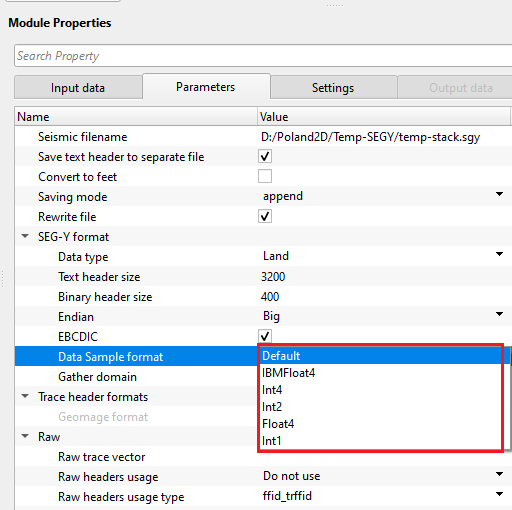
Default - IEEE format
IBMFloat4 - IBM 32 bit Floating point with 4 Bytes as sample size. Most legacy SEGY data is in this format.
Int4 - 32 bit Integer point with 4 Bytes as sample size.
Int2 - 16 bit Integer point with 2 Bytes as sample size.
Float4 - IEEE 32 bit Floating point with 4 Bytes as sample size. Modern SEGY data is in this format.
Int1 - 8 bit Integer point with 1 Byte as sample size.
Gather domain - allows the user to specify the input data domain type. By default, Time. There are additional domain options available from the drop down menu.
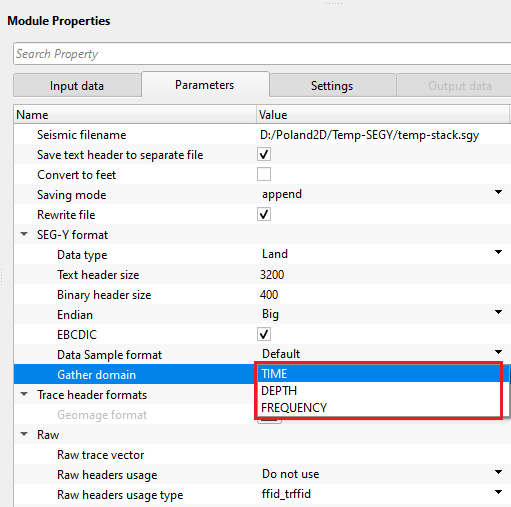
Time - Input data is in Time domain
Depth - Input data is in Depth domain
Frequency - Input data is in Frequency domain
Trace header formats { Geomage format, SegFormat, Seg-Y, rev.1, 2002, Geomage Office Post, Coordinates Only, Constant Elevation, VSP format, teapot_dome_3d, Test_gom } - it contains meta data of the seismic trace which means all the parameters like source point, FFID, channel number, source and receiver coordinates etc., are stored at certain byte locations. This is very crucial while saving the SEG-Y data. Make sure that the trace headers mapped correctly to their respective byte locations with correct format.
By default, Geomage format. This is a standard SEG-Y rev 1.0 format.
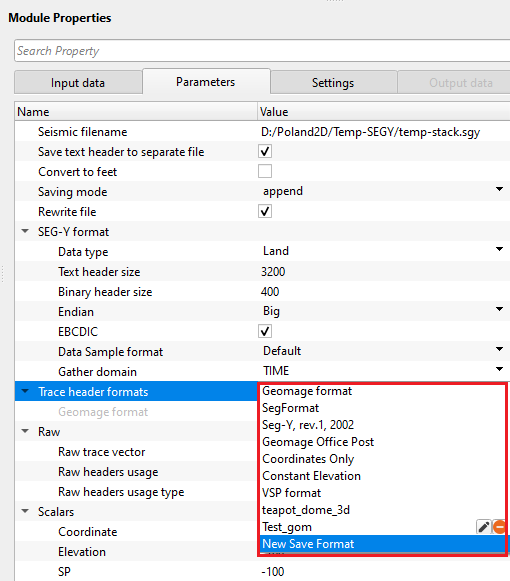
Raw -
Raw trace vector - It contains the binary headers information from the raw SEG-Y
Raw headers usage { Do not use, Sort according to raw headers, Sort according to and use raw headers, Use raw headers } -
Do not use - do not use the raw trace headers while writing the data.
Sort according to raw headers - sort the data according to the raw trace headers while writing the data.
Sort according to and use raw headers - preserve the sorting order during the processing and use the raw trace headers while writing the data.
Use raw headers - use the raw trace headers while writing the data.
Raw headers usage type { ffid_trffid, recordIndex } -
ffid_trffid - while writing/saving the data, it takes FFID & TRACE FFID from binary trace headers and uses it as a sorting order
recordIndex - it uses record index as a basis for sorting.
Scalars - scalars are used to multiply or divide the existing trace header values of coordinates/elevations/shot gathers.
Coordinate - specify the coordinate scalar value. By default, -100 (it divides the existing value by 100)
Elevation - specify the elevation scalar value. By default, -100 (it divides the existing value by 100)
SP - specify the shot point scalar. By default, -100 (it divides the existing value by 100)
Text header file - provide the path and file name of the text/EBCDIC header. It should be in any text file format.
![]()
![]()
Auto-connection - By default, TRUE(Checked).It will automatically connects to the next module. To avoid auto-connect, the user should uncheck this option.
Skip - By default, FALSE(Unchecked). This option helps to bypass the module from the workflow.
![]()
![]()
Output file name is provided within the parameters tab and there is no output data is generated as a connection/reference for next modules.
Number of traces written - displays the total number of traces written into the output file.
![]()
![]()
In this example workflow, we are saving a stack section. In the workflow, we read the stack by "Read seismic traces" module. Inside the parameter, we change Load data to RAM from No to YES. Connect/reference the Output gather from Read seismic traces to Input gather of Save SEG-Y module.

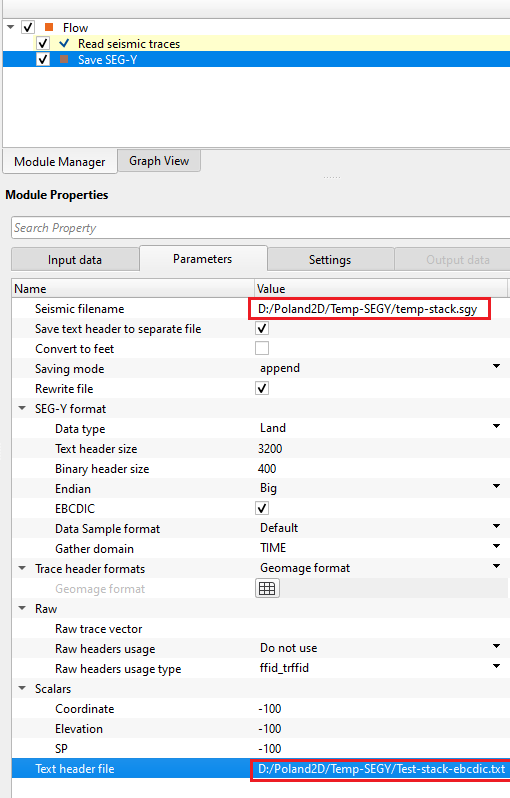
In the above image, we've provided the output segy file name & path. Also, we've provided the text/EBCDIC header information file in text format. It is not mandatory however if the user wants to create a custom text/EBCDIC header, it can be provided. In case the user provided external header file information & opted to "Save text header to separate file" option then it will save both the files in the same folder. One is the standard Geomage segy format trace header file and another one of the user provided.

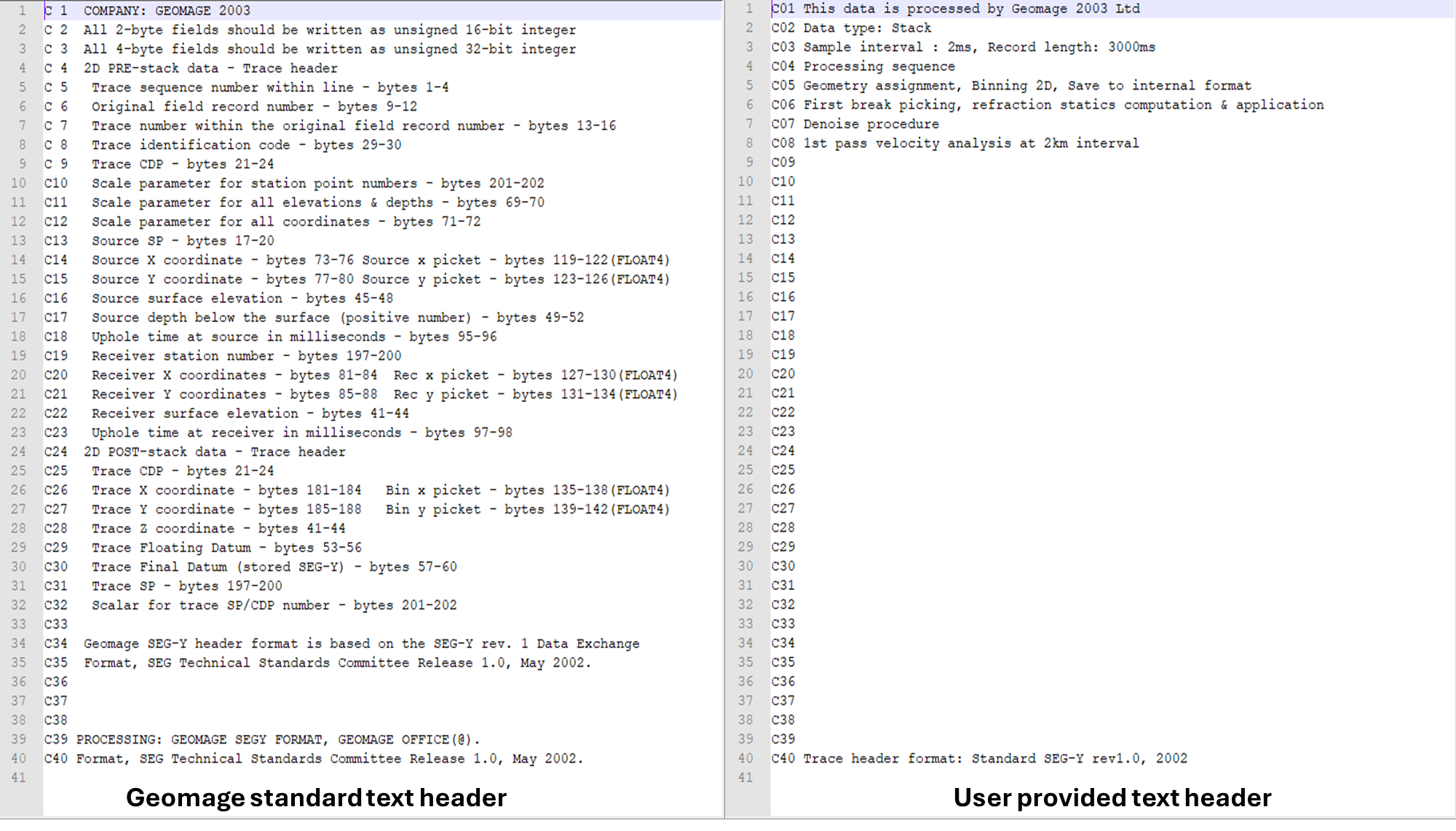
![]()
![]()
There are no action items available for this module so the user can ignore it.
![]()
![]()
YouTube video lesson, click here to open [VIDEO IN PROCESS...]
![]()
![]()
Yilmaz. O., 1987, Seismic data processing: Society of Exploration Geophysicist
 * * * If you have any questions, please send an e-mail to: support@geomage.com * * *
* * * If you have any questions, please send an e-mail to: support@geomage.com * * *
